Tomatoes "Khlebosolnye" loved by gardeners: we will grow a rich harvest, despite the weather conditions
The Khlebosolny tomato has gained great popularity among vegetable growers. The variety is loved for its high yield and excellent taste. The culture is able to grow and develop well even in adverse conditions. Thanks to Siberian breeders, the variety is successfully grown in regions with a cool climate.
The content of the article
Description of the variety
Hlebosolny tomato is adapted to the Siberian climate... The variety has a strong immunity, which allows you to grow a crop in any unfavorable conditions and collect a bountiful harvest at the same time. This tomato is famous for its excellent fruit taste.

Distinctive features
The culture belongs to the determinant type of plant, although the height of the bush reaches from 0.8 to 1 m. The variety is very sprawling. The stems must be tied to a support. Additionally, heavy fruits are supported so that branches do not break off from weighty brushes.
The variety is considered mid-season... The first tomato crop is harvested after 120 days. In the south and in the middle lane, the Khlebosolny tomato is grown in the open field. In the northern regions, tomatoes are cultivated in greenhouses. It doesn't matter what the greenhouse will be made of. The Khlebosolny variety grows well under film, glass or polycarbonate.
Siberian selection tomatoes are resistant to unfavorable growing conditions... The Khlebosolny variety easily tolerates dry weather, temperature drops and a sharp cold snap. The plant has strong immunity to fungal and viral diseases. Also, the crop shows good resistance to rotting.
Fruit characteristics, yield
Every vegetable grower is interested in the quantity and quality of the crop. Breeders have tried: the culture bears large fruits. One tomato weighs on average about 600 g... With good fertilization, tomatoes growing on the lower tier reach 1 kg. Also, the Bakery variety is valued for the excellent taste of the fruit. The pulp is fleshy, juicy and sweet. The tomato shell is thin, but strong enough. When eaten, it is practically not felt.
The fruits are round in shape with a flattened top and an area near the stalk... The walls are slightly ribbed. There are few seeds in the seed chambers. Ripe tomato color is red with a pinkish tinge.
On a note. Although the variety is large-fruited, harvested vegetables are stored for a long time during the period of technical maturity.
How to grow seedlings
Successful tomato cultivation depends on quality seedlings... So that the plants do not stretch out, the timing of planting seeds is observed. Sowing is carried out in the second half of March. Before planting plants in a permanent place of growth, the bushes will get stronger, grow up to 25 cm and have 3 pairs of leaves.
Seed preparation
For good germination, the seed must be fresh... Seed material is purchased from a gardening store or harvested from your own crop.
Before sowing, suitable grains are selected by soaking the seeds in salt water for 5-10 minutes (10 g of salt per 1 liter of water). The grains that float to the surface are of poor quality, they are thrown away, the rest are taken for planting.Next, suitable seeds are washed in clean water and placed in a 1% solution of potassium permanganate for 20-30 minutes, washed again and sprayed with a growth stimulator, for example, "Heteroauxin", "Epin" or "Kornevin".
For quick pecking of seeds two days before sowing, the grains are wrapped in a damp cotton cloth. The saucer with them is placed in a cool, dark place. Gauze with seeds is periodically moistened.
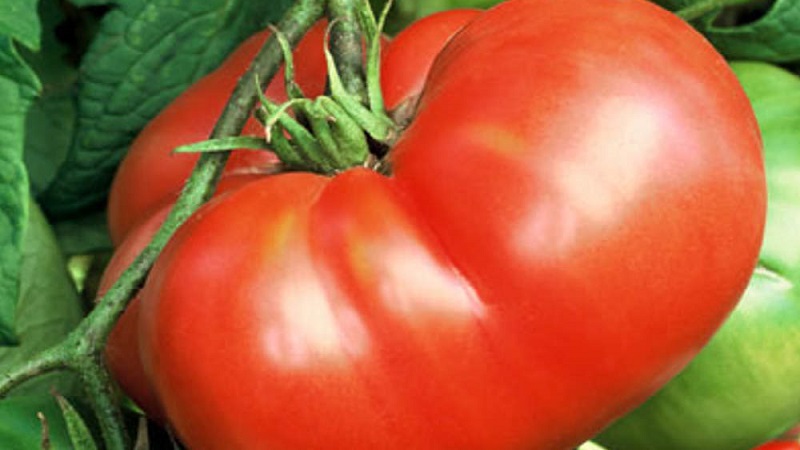
Capacity and soil
Seeds are sown in special seedling boxes or plastic containers... Cut milk or juice cartons are also used, but most often the seedlings are grown in peat cups or tablets. Several holes are made at the bottom of plastic or cardboard containers to drain excess liquid.
When sowing seeds in peat products, the process of plant diving is simplified... A glass with seedlings is placed in a large container. Peat eventually becomes limp and dissolves in the soil, and the plants themselves are not injured or stressed during transplantation.
To obtain strong seedlings, use high-quality soil:
- ready-made soil mixture for seedlings;
- self-prepared soil - mix garden soil, humus, sand (sawdust), wood ash in a ratio of 2: 1: 1: 1.
Before use, the soil is disinfected - pour boiling water or a weak solution of potassium permanganate. This procedure destroys all larvae and bacteria that cause plant diseases.
Sowing
Seeds are laid out in the grooves made according to the 3x5 cm scheme... When using disposable cups, no more than 1-2 seeds are planted in one container. The grains are deepened into the ground by 1-1.5 cm and sprinkled with a thin layer of sand and earth mixed in equal parts.
Next, the soil is gently sprayed from the sprayerso as not to wash out the ground. To do this, use settled water at room temperature. The container is covered with transparent glass or foil and placed in a warm place.
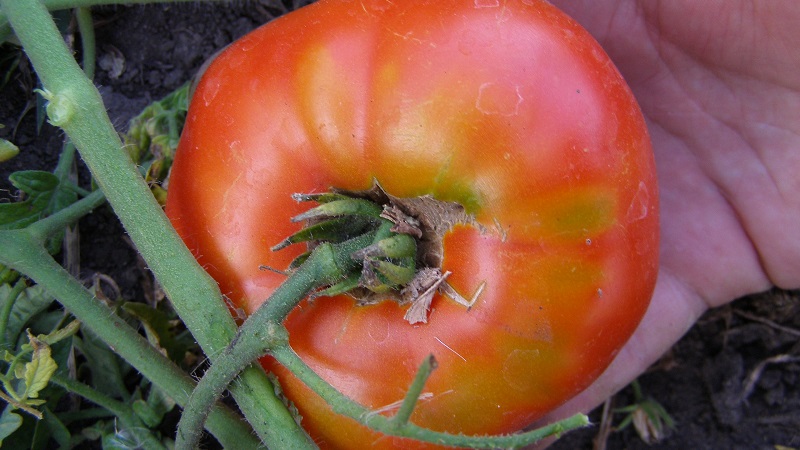
Growing and care
The temperature in the mini-greenhouse is maintained at around 21-23 ° С, and the air humidity is 60%.
Before germination, the container is periodically ventilated.so that condensation does not appear, and subsequently mold does not form on the soil surface. Also, the seedlings are regularly moistened with warm water, preventing the soil from drying out.
A week later, when shoots appear, the shelter is removed, and the air temperature is lowered to 15-17 ° C for 5 days. This procedure stimulates the growth of the root system and prevents the seedlings from pulling out. After this time, the plants are returned to a warm place.
Grade Hlebosolny - light-loving plant, therefore, the culture is provided with lighting for at least 14-16 hours a day.
If the seeds were planted in one container, then when the first true leaves appear, the plants dive. To do this, the tomatoes are well watered, an hour after moistening, they are carefully removed along with the ground and placed in separate containers. The lack of soil is replenished with a nutrient mixture from garden soil and humus (1: 1).
Before planting seedlings in a permanent place growing plants are hardened. So tomatoes take root better in a new place and grow quickly. Two weeks before the transplant, the bushes are taken out onto the street or balcony for a couple of hours. The residence time of tomatoes in the fresh air increases every day.
How to grow tomatoes
The culture is planted in a sunny and windless area with moderately moist soil. The soil should be light and soddy, with low acidity. The garden bed is prepared in the fall.
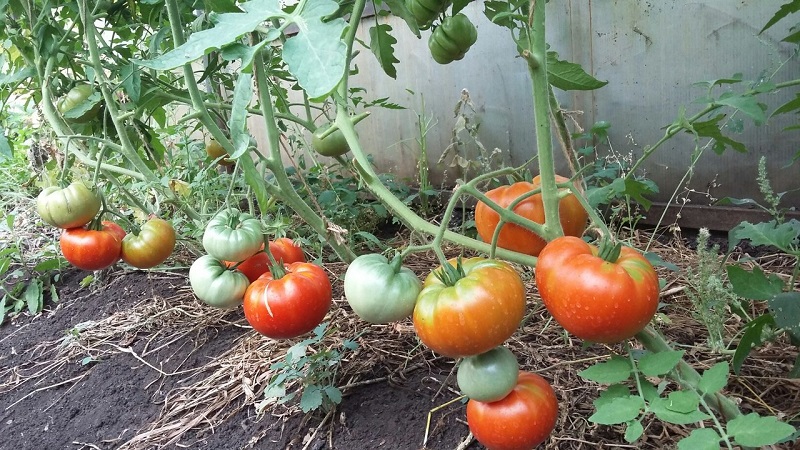
Crop rotation is also important, good predecessors:
- cabbage;
- cucumbers;
- onion;
- garlic;
- radish;
- carrot;
- legumes.
Weeds and residues of vegetation are removed... For 1 sq. m, 10 kg of leaf compost or rotted manure, 3-4 kg of wood ash, 80 g of potassium salt and 100 g of superphosphate are introduced. To reduce acidity, 300 g of chalk or slaked lime are added to the soil.
Next, the soil is well dug up, leveled and watered abundantly... The soil is disinfected 14 days before the intended planting. To do this, use the following means:
- urea solution - 1 tbsp. l. substances per 10 liters of water;
- concentrated solution of potassium permanganate.
Read about other large-fruited tomatoes:
Large-fruited and early ripe hybrid "Strega f1"
Landing
Optimal timing of planting tomatoes in the greenhouse - the first half of May, in the open ground - the last decade of the month.
Plants are planted according to the scheme 50x50 cm... For 1 sq. m place no more than 4-5 bushes. Wells are watered with water before planting. A support with a height of about 1 m is installed near each hole. The root system of plants is placed in the holes, sprinkled with soil and spud.
Important! For the first 3-4 days, the plants are covered from the scorching sun with burlap or agrofibre material, and covered with foil to protect against possible night frosts.
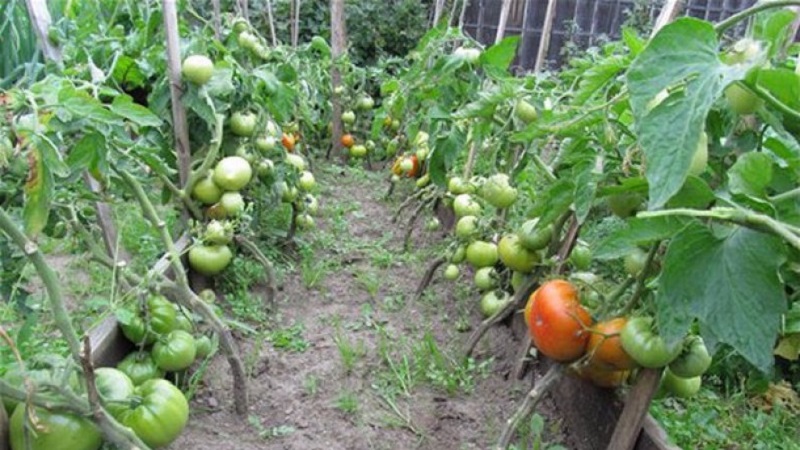
Care
In care, the Hlebosolny tomato is unpretentious, but to increase the yield, stepchildren are removed from the axils of the foliage to the first formed brushes.
Plants are watered every 5-7 days as the soil dries or every day with a little water until the fruit forms. Then the moisture is reduced. Watering is carried out with settled water at room temperature.
For rapid growth of stems, the culture is moistened once every 10 days with ammonium nitrate... To prepare the mixture, a matchbox of nitrate is stirred in a bucket of water. When watering, do not allow splashing on stems, foliage and flowers.
During the formation of the first brush with flowers, the soil is mulched hay, sawdust, weeds or organic fertilizers.
After watering, rains or cracking of the soil, carry out loosening the soil. This allows oxygen to penetrate to the root system. Weeds are removed as the beds overgrow.
Features of cultivation and possible difficulties
Agricultural technology of the variety of tomatoes Khlebosolny is no different from growing other tomatoes. To obtain a bountiful harvest, the crop is provided with timely watering and regular fertilization.
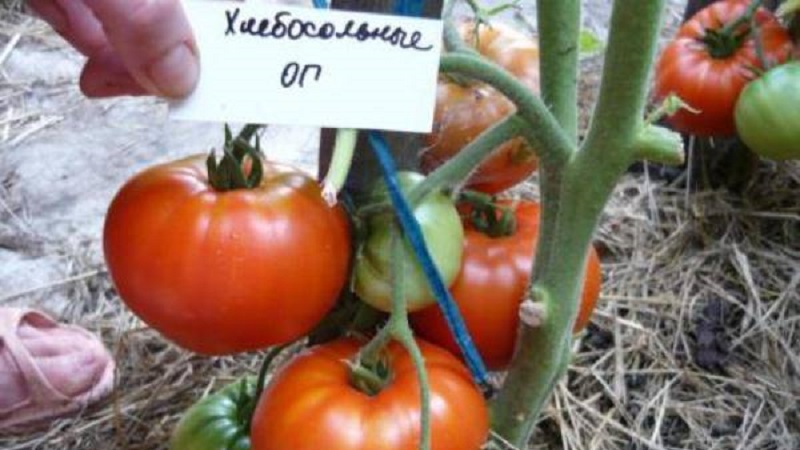
Diseases and pests
The Khlebosolny variety has good resistance to fusarium, late blight, tobacco mosaic, and other common nightshade diseases. A crop growing in greenhouse conditions is prone to white, gray, apical and root rot. To prevent diseases, the buildings are regularly ventilated, the lower leaves and weeds are removed, the soil is mulched with humus or straw. Also, plantings are sprayed with a weak solution of potassium permanganate or phytosporin.
When growing tomatoes in the open field the culture is often affected by spider mites, whiteflies and aphids. Aphids are eliminated by washing the affected areas with a mixture of water and laundry soap. The tick is destroyed with the preparations "Taran", "Medilis-tsiper" or "Sipaz super". Do not use toxic agents before fruiting.
The nuances of growing in open ground and in a greenhouse
No more than 3 hilling operations are carried out per season, especially if the water has washed away the root system of the plants, as they grow, the lower leaves are cut off. When the first flowers and fruits are formed, the bushes are tied to a support.
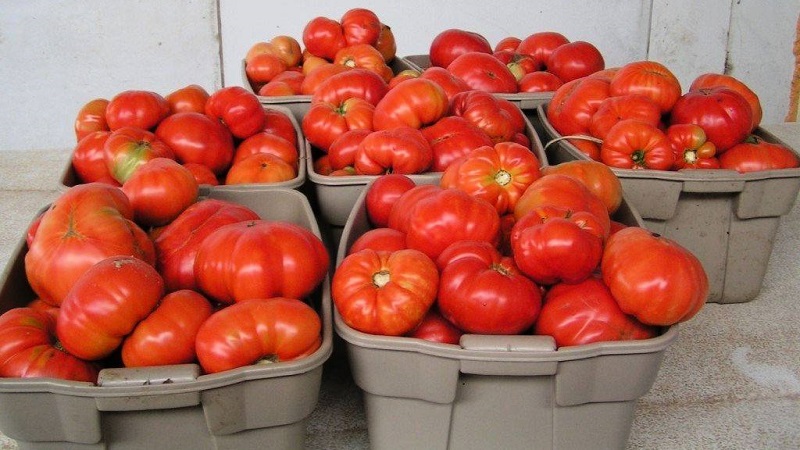
Harvesting and application of the crop
The fruits of this variety ripen in about 4 months.... Harvested in the morning, when the sun is not beaming. Some growers pick tomatoes green. Vegetables ripen perfectly at home. If you want to collect your own seeds, wait until the tomatoes are fully ripe.
Bread-salted tomato is considered a salad variety... Vegetables are used for preparing various dishes, they are suitable for baby and diet food. Tomatoes are also processed into juice, tomato paste and ketchup.
Attention! Tomatoes are not suitable for preservation: the size of the vegetable will not fit into the neck of the jar.
Advantages and disadvantages of the variety
Many positive qualities make the Khlebosolny variety more and more popular among vegetable growers.
Benefits of tomato:
 during transportation, tomatoes are not deformed and retain their presentation;
during transportation, tomatoes are not deformed and retain their presentation;- tomatoes do not crack or fall off;
- vegetables ripen in a short time;
- you can grow a crop in a greenhouse and in the open field;
- good seed germination;
- long shelf life;
- strong immunity to disease;
- resistance to temperature extremes;
- high yield, even in adverse conditions;
- vegetables have excellent taste and a strong pleasant aroma.
Disadvantages of the variety:
- the need to tie plants to a support;
- the impossibility of preserving fruits.
Farmers reviews
Hlebosolny tomato is a great option for amateur gardeners... They grow in any conditions. Productivity directly depends on the care of tomatoes.
Vera, Odintsovo: “In a gardening store, the seller advised me to buy seeds of the Khlebosolny variety. I liked the photo on the package. The tomato was grown in a greenhouse. The fruit tastes great. One vegetable weighs an average of 500 g. She took 10-12 fruits from each plant. I made juice and preservation from tomatoes. She peeled the peel, cut it into pieces, boiled it and filled it with yellow cream. In winter, these tomatoes in their own juice were eaten first. ".
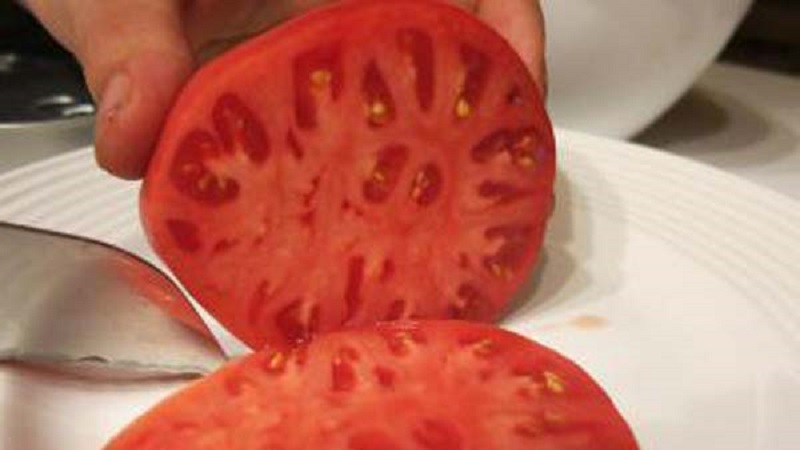
Ekaterina, Bryansk: “Last year, I planted the Khlebosolny tomato variety in open ground. The result pleased me. The culture was not sick. I tied up the bushes, put the lower brushes on the boxes, and the upper ones hooked to the trellis. Harvested a lot. I took off some of the tomatoes green and put them in a dark place. The tomatoes ripened well on their own. The vegetables taste great. Next time I will grow this variety again ".
Conclusion
The Khlebosolny tomato is successfully grown in regions with a cool climate. The short cold summer is not a hindrance to the crop: even with minimal maintenance, the plant produces large and tasty vegetables. The tomato has a strong immunity to disease, which makes it easy to cultivate this variety.